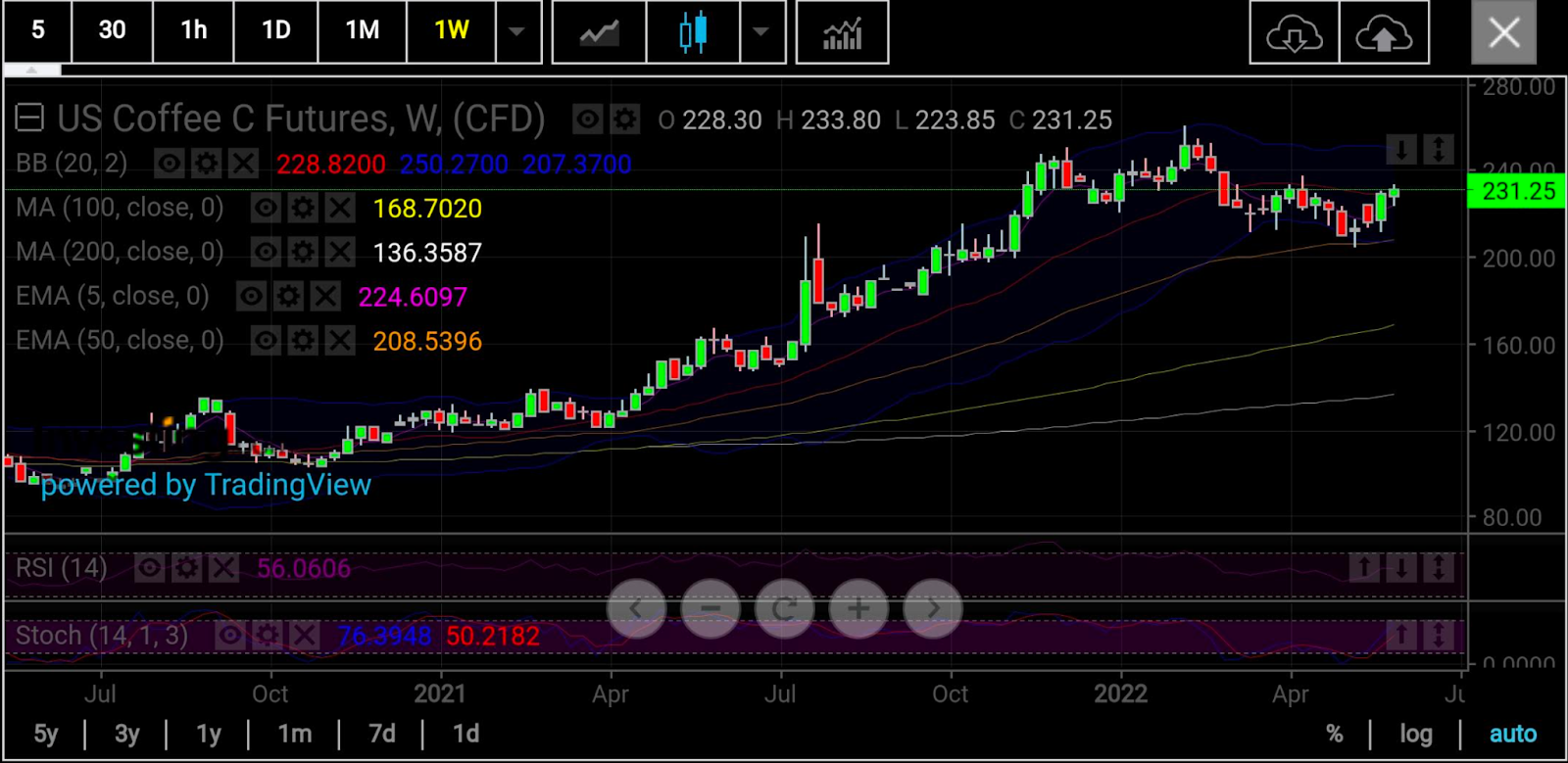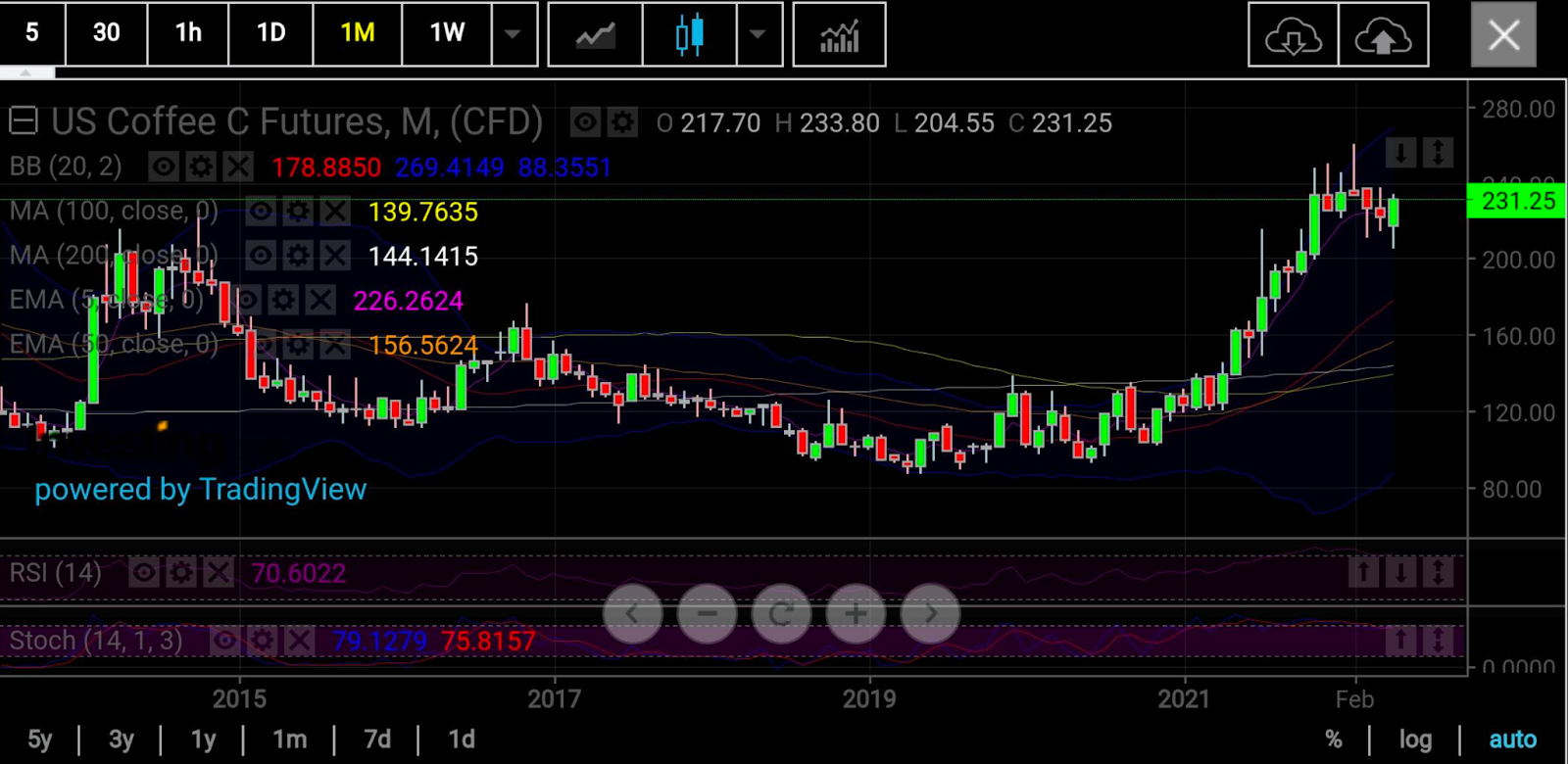Arabica coffee futures finished higher in May, for the first time in four months. But is the sell-off that began at the end of January over?
The commodity’s charts suggest so, although questions remain about European demand amid the festering war in Ukraine and of buying support from China in the near term as the giant importer of all raw materials struggles to close its recent episodes with COVID.
Consumed by more than two-thirds of the coffee-drinking world, arabica, which is largely grown in Brazil, ranks as the bean of choice for renowned coffee chains from Starbucks (NASDAQ:SBUX) to Restaurant Brands' (NYSE:QSR) owned, Tim Hortons and Dunkin' Donuts. The other coffee variant, robusta, is largely grown in Vietnam and is the premier choice of instant-coffee makers.
Arabica’s front-month coffee contract on ICE Futures US settled May trading at $2.3185 per lb, up 4.4% for the month. In three prior months, it had lost a cumulative 5.5% from January’s settlement of $2.3510.

All charts courtesy of skcharting.com
Arabica’s last big month was in November when it gained 14.4% after soaring to a 10-year high of $2.4755. It did go higher from there, reaching a new decade peak of $2.6045 in February, before an onslaught of volatility that eventually turned into the three-month-long selloff.
But arabica’s technicals now show that May’s rebound could have legs.
“Arabica futures’ daily chart is strong, with prices trading above the 200- and 100-Day Simple Moving Averages,” Sunil Kumar Dixit, chief technical strategist at skcharting.com, said, adding:
“Taking out the $2.40 level can help coffee test the $2.50-$2.60 rather quickly.”
But Dixit also cautioned that overbought stochastic conditions in arabica could result in limited consolidation to between $2.30 and $2.20.
“Prices need to sustain above $2.11 to continue the upward momentum,” Dixit said, adding:
“Weakness below $2.04 can push coffee to the $1.98-$1.90 support areas.”

Fundamentally, the outlook for coffee is between good and fair, say analysts who track the crop.
“The outlook for dry conditions in Brazil over the next week has sparked short-covering in coffee futures,” analyst Rich Asplund said in a blog published on Thursday, where he cited weather readings from Somar Meteorologia which suggested limited chance of precipitation in Brazil's coffee-growing regions this week.
According to Somar Meteorologia, Brazil’s key coffee patch in Minas Gerais received 11.5 mm of rain over the past fortnight or 52% of the historical average. Minas Gerais accounts for about 30% of Brazil's arabica crop.
Strength in the Brazilian real was also bullish for arabica after it rallied to a one-month high against the dollar lately. A stronger real discourages export selling from Brazil's coffee producers.
The Colombian Coffee Growers' Federation reported on May 5 that Colombian April coffee exports dropped 18% year-on-year to 845,000 bags, a factor supportive to arabica, with Colombia being the world's second-largest producer.

Signs of smaller global coffee supplies are bullish for prices after the International Coffee Organization reported on May 2 that global 2022 coffee exports during October-March fell 0.1% year-on-year to 66.25 million bags.
Balancing that bullish outlook was Rabobank’s bearish projection from last week that the global 2022/23 coffee market might revert to a surplus of 1.7 million bags compared with a deficit of 5.1 million bags in 2022/22.
Rabobank expects Brazil 2022/23 coffee production to climb 14% year-on-year to 64.5 million bags. Also, the war in Ukraine and China's persistent battles of late with COVID were expected to temper global coffee demand, it said.
Jack Scoville, chief crop analyst at Chicago’s Price Futures Group, concurred with Rabobank’s outlook on the Ukraine and China impact.
“The Ukraine war is supporting ideas of less demand from Europe generally,” Scoville said,” adding:
“Demand from China is thought to be less due to the war against COVID.”
China has set a 5.5% target for economic expansion this year, the lowest in three decades, after the two-month-long Shanghai COVID lockdown which was just ending this week. Premier Li Keqiang told officials last week that China could struggle to achieve positive growth at all in the current quarter.
Disclaimer: Barani Krishnan uses a range of views outside his own to bring diversity to his analysis of any market. For neutrality, he sometimes presents contrarian views and market variables. He does not hold positions in the commodities and securities he writes about.
